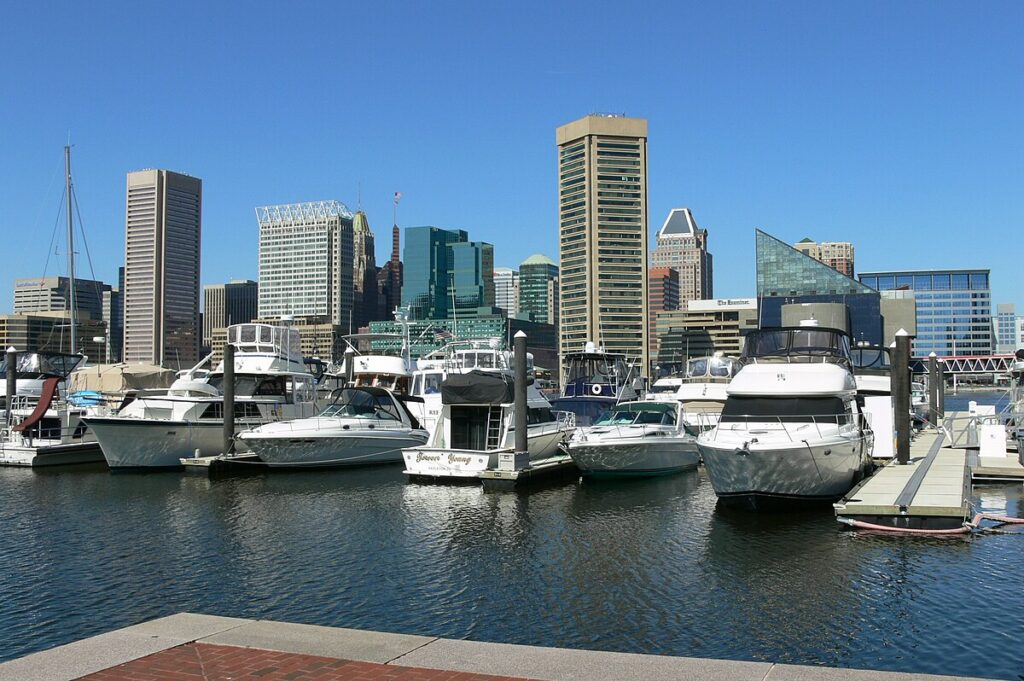
Moving to Baltimore, Maryland: A Comprehensive Relocation Guide
Considering moving to Baltimore, Maryland? This historic port city offers Inner Harbor beauty, Johns Hopkins excellence, and diverse neighborhoods. With approximately 585,000 residents in 2025 (metro 2.8 million+), Baltimore combines working-class grit with cultural richness and Maryland’s largest city character.
Demographic Profile to Consider If Moving to Baltimore:
Baltimore’s 2025 population is approximately 585,000 residents, making it Maryland’s largest city, with the metro exceeding 2.8 million. The median age is around 35 years, with diverse families, Johns Hopkins employees, young professionals, and working-class residents. The population is approximately 62% Black or African American, 29% White, 5% Hispanic, 3% Asian. Baltimore features iconic Inner Harbor, diverse neighborhoods from Federal Hill to Hampden, Johns Hopkins institutions dominating healthcare and education, and serves as a major East Coast port city. The city attracts Johns Hopkins medical and academic professionals, young adults seeking DC/Baltimore affordability, diverse residents, and those wanting urban living with history. Baltimore appeals to those prioritizing diversity, Johns Hopkins opportunities, affordability for the region, and authentic urban character. The community balances working-class roots with Johns Hopkins excellence and neighborhood pride. Find trusted local services for moving, living, and working in Baltimore.Baltimore Relocation Directory
Cost of Living to Consider If Moving to Baltimore:
Baltimore offers exceptional affordability for the DC-Baltimore corridor. Median home values range from $180,000 to $350,000 in 2025, varying dramatically by neighborhood from very affordable to upscale areas like Roland Park and Guilford. The median household income is approximately $54,000. Rental properties average $1,200 to $2,000 monthly. Maryland has progressive income tax 2%-5.75%. Property taxes are significant. Overall cost of living is very competitive for proximity to DC (45 minutes) and major metro amenities, making Baltimore highly attractive for young professionals, Johns Hopkins employees, and those seeking East Coast urban affordability. The city provides tremendous value with major city amenities at reasonable costs. Housing costs create accessibility though neighborhood selection is critical.
Economy and Job Market:
Baltimore’s economy revolves around Johns Hopkins (massive employer with hospital, university, research), healthcare, port operations, and diverse sectors. Major employers include Johns Hopkins Hospital and Health System (world-renowned medical center employing tens of thousands), Johns Hopkins University, University of Maryland Medical System, Baltimore City government, Under Armour (headquarters), T. Rowe Price, Port of Baltimore, and biotech companies. Healthcare dominates employment with Johns Hopkins creating medical excellence. Port operations remain significant. Typical industries include healthcare, education, port/logistics, biotech, and services. The diverse economy provides opportunities. Johns Hopkins offers world-class medical careers. The job market attracts healthcare professionals, researchers, biotech workers, and diverse talent seeking urban opportunities with DC proximity.
Education:
Baltimore City Public Schools serves city students with numerous schools. School quality varies dramatically requiring extensive research with some excellent magnet and charter schools and others struggling significantly. Johns Hopkins University offers elite education and medical school. University of Maryland Baltimore provides professional programs. Loyola University Maryland and other colleges serve the area. The educational infrastructure presents challenges though Johns Hopkins creates academic excellence and excellent private schools exist.
Recreation and Lifestyle:
Baltimore offers iconic Inner Harbor with National Aquarium (world-class), historic ships, waterfront dining, and tourist attractions. The city features diverse neighborhoods each with distinct character – Fells Point (historic waterfront with cobblestones and bars), Federal Hill (young professionals with Inner Harbor views), Canton (waterfront living and dining), Hampden (quirky shops and Café Hon), Mount Vernon (cultural district with Walters Art Museum), and many others. Residents enjoy Orioles baseball at Camden Yards (beautiful ballpark), Ravens football at M&T Bank Stadium, Fort McHenry National Monument (Star-Spangled Banner history), American Visionary Art Museum, Baltimore Museum of Art, exceptional seafood especially blue crabs, vibrant neighborhoods, and authentic urban character. The lifestyle emphasizes neighborhood identity and pride, diverse culture, blue crab culture, sports passion (Orioles and Ravens), affordability for East Coast urban living, and authentic character. The four-season Mid-Atlantic climate features hot, humid summers and cold winters. The community values neighborhood loyalty (asking “what neighborhood?” defines Baltimore), Johns Hopkins excellence creating world-class medicine, blue crab heritage, sports teams, working-class authenticity, and resilience. Living in Baltimore means accepting significant crime challenges in some neighborhoods requiring careful area selection, struggling public schools necessitating private options or charter research, urban challenges, some areas with vacant homes, prioritizing neighborhood research critically, and choosing authentic urban character and affordability while experiencing exceptional East Coast urban affordability, Johns Hopkins world-class medical excellence, Inner Harbor beauty, vibrant distinct neighborhoods, blue crab culture, Camden Yards perfection, and diverse authentic character creating the DC area’s most affordable major city where neighborhoods define identity and Johns Hopkins meets blue crabs in Maryland’s gritty but charming largest city.
Healthcare and Services:
Baltimore residents access world-class healthcare through Johns Hopkins Hospital (consistently ranked #1 or near top nationally), University of Maryland Medical Center, other excellent hospitals, and the concentration of medical facilities. The Johns Hopkins presence creates unparalleled medical care and research excellence.
Transportation:
Baltimore is accessed via Interstate 95, Interstate 83, Interstate 695 (Beltway), and various corridors. Baltimore/Washington International Airport (BWI) is 15 minutes south. Maryland Transit Administration (MTA) operates subway, light rail, and extensive bus service. MARC trains connect to DC. Amtrak serves Penn Station. Many neighborhoods offer walkability. Some residents bike. Most own cars though public transit is viable for some. Typical commute times to DC are 45-75 minutes by car, 1 hour by MARC train.
Conclusion:
Moving to Baltimore in 2025 offers affordable East Coast urban living with Johns Hopkins excellence, Inner Harbor beauty, and diverse neighborhoods. The city’s combination of world-class medicine, exceptional affordability for the region, and authentic character makes it ideal for healthcare professionals, young adults, and those seeking Maryland’s most diverse destination where Johns Hopkins meets blue crabs and neighborhood pride defines the DC area’s most affordable and authentic major city.

